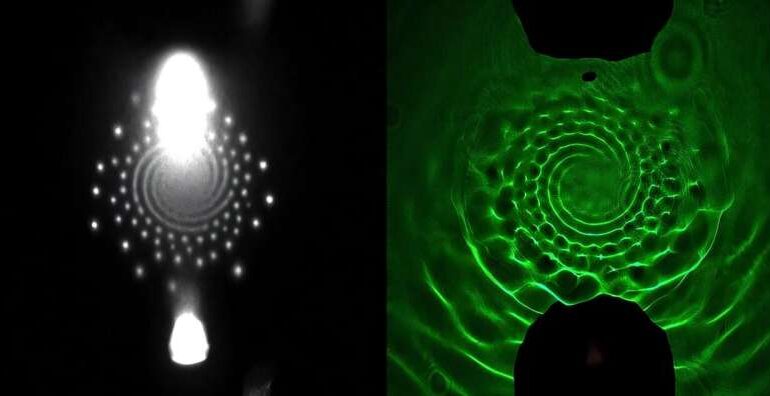New Plasma Technology Offers Hope for PFAS Destruction in Water

Research from the University of Michigan has unveiled a new technology that utilizes self-organized plasma patterns to effectively eliminate per- and polyfluoroalkyl substances (PFAS) from contaminated water. Published on November 10, 2025, the study highlights how manipulating plasma interaction with water can significantly enhance the destruction of these dangerous contaminants known for their persistence in the environment.
The research team discovered that under specific conditions, plasma can form intricate, self-organized patterns upon contact with water. These patterns, which resemble shapes like stars or gears, increase the surface area where plasma interacts with water. This phenomenon is crucial since it could lead to more efficient methods of decontaminating drinking water, especially in removing PFAS, which are commonly found in firefighting foams and non-stick coatings.
The study, published in Plasma Sources Science and Technology, captures groundbreaking images of the water surface beneath the self-organizing plasma. The findings indicate that the plasma exerts an electrical force that distorts the water surface, generating surface waves. Researchers found that the characteristics of these waves could be manipulated by altering the gas heating rate and the electrical properties of the water, potentially allowing for larger plasma surface areas to treat more water simultaneously.
PFAS, often referred to as “forever chemicals,” are notorious for their resistance to degradation due to strong carbon-fluorine bonds. When these substances infiltrate ground and surface water, they can accumulate in the food chain and pose serious health risks, including cancer and endocrine disruption. Traditional water treatment methods have struggled to effectively eliminate PFAS, making advanced technologies necessary.
According to John Foster, a professor of nuclear engineering and the study’s senior author, “Laboratory demonstrations show cold plasma can get rid of a lot of contaminants in water, removing them almost completely. It opens up a new opportunity to treat these legacy chemicals.” The cold plasma does not heat the water, making it suitable for broader applications, including medical treatments.
The research identified that plasma generates ions, solvated electrons, and ultrasound waves upon contact with water, which can effectively break the strong bonds in PFAS compounds, reducing them to harmless byproducts. Despite its effectiveness, the energy-intensive process of plasma injection presents challenges for large-scale industrial applications.
A unique aspect of this research is the examination of “entropy-reversing patterns” that emerge as plasma interacts with water. Instead of dissipating, these patterns grow increasingly complex, allowing for greater interaction with the water’s surface. Foster explains that these processes are driven by non-equilibrium thermodynamics, where energy and reactive species are deposited locally, avoiding thermodynamic equilibrium. This self-organization could enhance the efficiency of water treatment.
The discovery was made more visible when Zimu Yang, a doctoral graduate and first author of the study, noticed the textured surface of the water while observing it under a specific light. “The deformed liquid surface had always been there, but I suddenly realized… Science is everywhere, pure and coherent,” Yang remarked.
To further investigate these interactions, the team developed a specialized high-speed camera setup to capture the rapid plasma-water interactions occurring within approximately 10 microseconds. This setup allowed them to synchronize high-speed camera shots with the plasma pulses, revealing that the plasma patterns indeed cause the water deformation, rather than the other way around.
The researchers hope that by controlling these patterns and enhancing their size, plasma technology can be scaled to treat larger volumes of water, ultimately leading to its integration into existing water treatment facilities. Yang emphasized the significance of this innovation, stating, “If this could be controlled and perhaps enlarged, plasma methods can be scaled up to treat larger volumes and ultimately be integrated into water treatment plants to remove contaminants, including PFAS.”
In summary, the University of Michigan’s innovative approach to using self-organized plasma patterns presents a promising avenue for addressing the pervasive issue of PFAS contamination in drinking water. As research continues, the potential for this technology to transform water treatment processes could significantly impact public health and environmental safety.






